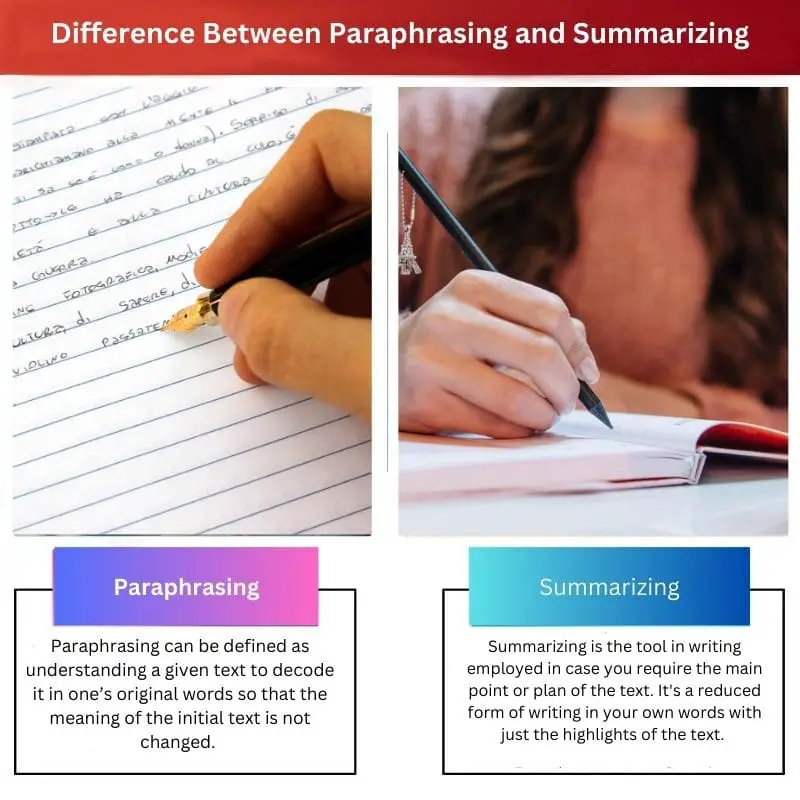In various spots, such as writing a research paper, we look at and pull selective data from multiple sources as it assists in supporting our theme.
Key Takeaways
- Paraphrasing involves rephrasing a passage or text in one’s own words while maintaining the original meaning and overall message, used to clarify or avoid plagiarism.
- Summarizing is condensing a longer text or passage into a shorter, more concise form that captures the main points, ideas, or arguments without providing all the details.
- Both paraphrasing and summarizing involve restating information from a source. Still, paraphrasing retains the original level of detail while using different words, while outlining focuses on presenting the main points more concisely.
Paraphrasing vs. Summarizing
Paraphrasing involves restating the ideas presented in a source using different words and sentence structures. It is used to incorporate information from a source into one’s writing without directly quoting it. Summarizing involves condensing the main ideas and key points of a longer piece of writing into a shorter version.

On the one hand, Paraphrasing is after you place the concepts of another writer into your own words.
On the other hand, Summarizing is after you use your own words to extend the initial text’s key points or main arguments, considerably reducing its length.
Comparison Table
| Parameter of Comparison | Paraphrasing | Summarizing |
|---|---|---|
| Definition | Paraphrasing is writing any specific text in your own words | summarizing is mentioning solely the most points of any add your own words. |
| Text size | Paraphrasing is sort of the same in size or somewhat like the initial text | summarizing is considerably shorter than the initial. |
| When to use | You paraphrase after taking notes or make a case for a chart or diagram to somebody. Paraphrasing helps highlight the necessary components of a bigger text. It additionally permits you to change the concepts for your readers. | An outline/summary permits you to require a bigger portion of the text, if not the complete document, and discuss mostly the main concepts and themes in very few sentences. It’s useful to summarize after you wish to give your reader background data on a text while not having to give an excessive amount of detail. |
What is Paraphrasing?
Paraphrasing can be defined as understanding a given text to decode it in one’s original words so that the meaning of the initial text is not changed.
In simple language, paraphrasing is like grasping the concept of a few topics from another writer’s work and then remodeling it into your way of thought and words.
Paraphrasing is needed to prove your purpose or point. It supports the material, adding credibility and depth to your work.
It is used as:
- When another writer’s work needs to be used for your writing.
- When quotes don’t seem to be utilized in the text.
- When the concepts have a bigger relevancy than the fashion of writing.
- When you wish to ease out another person’s work for better understanding.

What is Summarizing?
Summarizing is the tool in writing employed in case you require the main point or plan of the text. It’s a reduced form of writing in your own words with just the highlights of the text.
In simple language, Summarizing points to those writings or contents that show the main point of the initial or current writing you are working on.
It is used as:
- When only the chief concepts of the author are to be known.
- When only an outline of the full work is needed.
- When simplification is needed.
- When only the chief highlights of the work have to be summarized.

Main Differences Between Paraphrasing and Summarizing
- Paraphrasing could also simplify the initial work, whereas summarizing is done to show just the key points with no reasonable explanation regarding the matter.
- While paraphrasing, it’s vital to avoid plagiarism and create your text or document of additional quality and originality.

- https://www.sciencedirect.com/science/article/pii/S1060374312000203
- https://ila.onlinelibrary.wiley.com/doi/abs/10.1598/RT.63.1.7

The article effectively presents the concept of paraphrasing and summarizing
I found the real-world examples used in the article very helpful.
The article presents both methods in a well-structured manner.
Indeed, it’s quite beneficial for anyone engaged in academic writing.
Very well-written and informative piece!
I appreciate the subtle comparison made between the two techniques.
Totally, it helps to grasp these concepts better than many other sources.
The article provides a very practical set of guidelines.
It does indeed. It simplifies what can be a complex topic.
This article is a must-read for anyone serious about academic writing.
Absolutely, the explanations are thorough and well-presented.
This article provides valuable insights for academic writing.
It also serves as a great reference material for students.
I couldn’t agree more. It clarifies the distinctions between the two techniques effectively.
The explanations are precise and insightful.
Useful article to become a better academic writer
I totally agree, it provides a clear understanding of the differences between paraphrasing and summarizing.
The article provides a clear understanding of the nuances between paraphrasing and summarizing.
Absolutely, it’s a valuable resource for students and researchers.
I found the in-depth comparison really enlightening.
It’s a great guide for anyone looking to improve their writing skills.
Yes, the article provides a comprehensive analysis of the two methods.